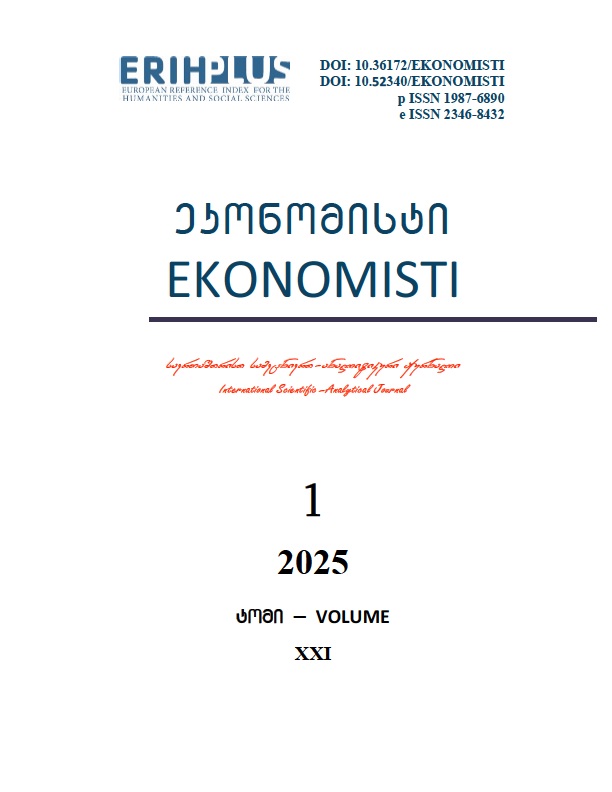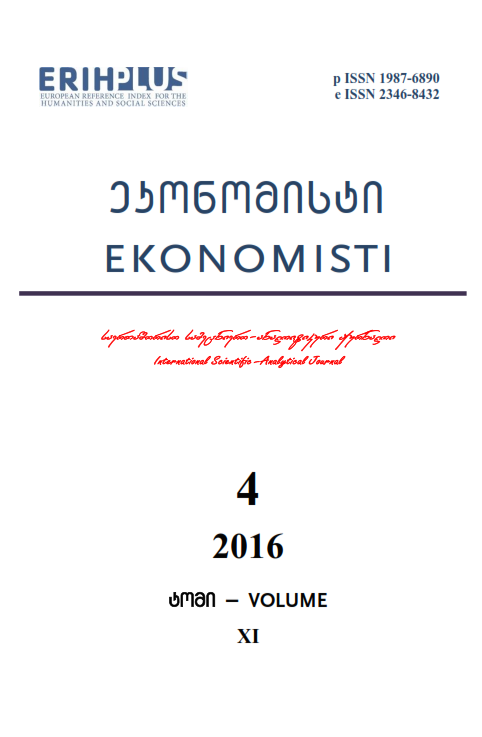
The international scientific and analytical, reviewed, printing and electronic journal of Paata Gugushvili Institute of Economics of Ivane Javakhishvili Tbilisi State University

ON THE NECESSITY OF MODIFICATION OF THE INFLATION INDEX FOR THE RELATIVELY POOR WORLDS AND GEORGIA’S EXPERIENCE
Summary
The inflation index fails to fully reflect the expectation of the poor part of the population, because some of the commodity groups (e.g. electronics, cars, furniture, hotel and restaurant services, etc.) do not reflect the problem of the low-income population.
Using the inflation index alone cannot guarantee successful decision-making.
Under these conditions, a logical question arises concerning the kinds of problems which might occur when the main goal for a central bank’s monetary policy is only to retain price stability. This is known as inflation targeting.
It should be mentioned that the NBG (starting from 2009), like the central banks of Georgia’s main trade partner countries (Turkey, Russia, Azerbaijan, Belarus, etc.), has already been exercising inflation targeting for years.
Central banks employing inflation targeting frequently justify their decisions to do so and state that they have reached not only their desired target (price stability) but have also contributed to stable economic growth such as, for example, was announced by Canada’s central bank. The fact that the average inflation level was comparatively low in both developing and developed countries utilizing inflation targeting is proven by research studies.
This said, however, inflation targeting does have serious opposition. For example, Joseph Stiglitz, the Nobel Prize winner in Economics, is almost confident that this system will be changed because the central banks of developing economies are incapable of managing their inflation which is frequently imported.
The Bank for International Settlements resists inflation targeting which, in most cases, runs counter to financial stability. Inflation targeting does not take into account the financial cycle and thus produces an excessively expansionary and asymmetric monetary policy. It is noteworthy that inflation targeting creates a great deal of questions. A major argument in favor of inflation targeting – that it has contributed to a decline in inflation since the early 1990s – is questionable at best. From the 1980s on, the inflation trend was already on the decline where globalization and China’s integration into the world economy – and not inflation targeting – have probably been the most important reasons for the drop.
It is a fact that Georgia, like other developing and, especially, poorer and import-dependent countries, is experiencing problems that cannot be fully explained by the inflation index alone. In particular, such examples for Georgia are: 80% of the consumer basket comprises imported products, and therefore, inflation is also to a certain degree imported; a high level of dollarization takes place (over 70% by the end of 2016).
For countries where import exceeds export by several times, it should be clear that calculations must be made not only by the traditional inflation index but also according to their consumer basket made up exclusively of imported goods and services (imflation).
Given that the Georgian consumer basket contains many goods and services (both imported and domestic) which are generally not purchased by lower-income citizens, neither inflation nor the imflation index will meet the goal of assessing price dynamics in those spheres important for the poorer population, especially in developing countries.
Agrarian inflation (or the growth of average prices for agricultural products) or the agflation index, becomes more and more popular in economics. The term “agflation” is relatively new and its introduction is associated with the substantial increase in the prices for fruit, eggs, grain and other commodities in 2006-2007. The agflation measurement is very important in developing and, especially, poorer countries which are characterized by permanent increases in foodstuff prices (for example, in India).
The agflation (agrarian inflation) index use area is restricted because it fails to reflect the change in prices on such substantial spheres as medication and utilities.
In the paper we propose a new statistical indicator, munflation, which reflect price fluctuations on the medication, utilities and nutrition.
The respective parameters for medication, utilities and food products from the consumer basket should be used for a munflation calculation. Food products prices are also used for the agflation calculation.
The issue of the possibility of extending the existing inflation targeting practice and studying the indicators of imflation, agflation and munflation in developing and relatively poorer countries, together with the inflation index, is the subject for a separate study.
Keywords: inflation, inflation targeting, imflation, agflation, munflation.

